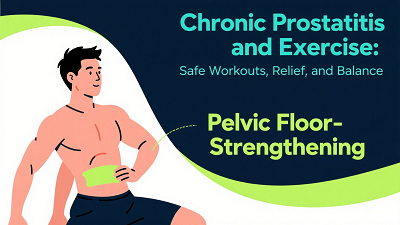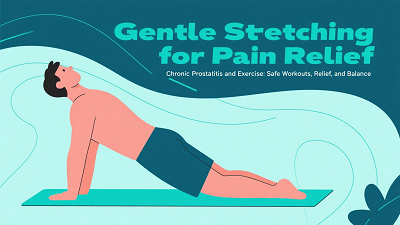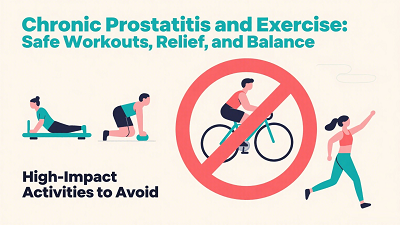Chronic Prostatitis and Exercise: Safe Workouts, Relief, and Balance
Chronic prostatitis, especially chronic prostatitis/chronic pelvic pain syndrome (CP/CPPS), is a condition that challenges both doctors and patients. Men living with this disorder often describe persistent pelvic discomfort, a constant urge to urinate, and a decline in sexual health. These symptoms can last for months or years, leading to frustration and reduced quality of life.
While conventional treatments include antibiotics, alpha-blockers, and anti-inflammatory drugs, patients are increasingly seeking complementary approaches. One of the most common questions is: “Can exercise help, or will it make things worse?” The answer is not black and white—exercise can be therapeutic if done correctly, but harmful if approached without care.

The Dual Role of Exercise in Chronic Prostatitis
Exercise is often described as “medicine without a prescription,” but in the case of prostatitis, it must be carefully tailored.
The Benefits:
- Improved blood circulation reduces pelvic congestion.
- Aerobic activity lowers inflammation markers and boosts immunity.
- Physical activity helps reduce anxiety and depression, which are common in men with chronic pain.
The Risks:
- Exercises that apply constant pressure on the perineum (e.g., long-distance cycling with a hard seat) can aggravate prostate irritation.
- Heavy lifting without proper breathing increases intra-abdominal pressure, worsening pelvic tension.
- Overtraining may cause symptom flare-ups, leading to setbacks in recovery.
Finding balance means choosing the right type of exercise, maintaining proper intensity, and allowing sufficient recovery time.
Best Types of Exercise for Chronic Prostatitis
Aerobic Exercise
Moderate-intensity aerobic exercises—such as brisk walking, swimming, or elliptical training—are strongly recommended. Research shows that men who engage in 3–4 aerobic sessions per week report significant improvement in pain and urinary symptoms [1]
Tip: For cycling enthusiasts, invest in a prostate-friendly saddle with a center cut-out to relieve perineal pressure.
Stretching and Pelvic Floor Relaxation
Contrary to popular belief, Kegel exercises are not always helpful for men with prostatitis, as they may tighten already tense pelvic muscles. Instead, focus on:
- Yoga poses like Child’s Pose or Happy Baby* for pelvic release.
- Gentle hip and lower back stretches to ease muscle tension.
- Diaphragmatic breathing, which reduces pelvic floor hypertonicity.
Strength Training with Adjustments
Strength training is safe, provided that:
- Weights are moderate, not extreme.
- The Valsalva maneuver (holding breath during lifting) is avoided.
- Core stability exercises are included to support pelvic alignment.
Mind-Body Practices
Mind-body exercises, such as Tai Chi or Qigong, combine gentle movement with relaxation. These practices not only improve circulation but also reduce stress hormones, which play a role in symptom flare-ups [2].

Practical Guidelines for Patients
- Start small: Begin with 20 minutes of walking, then gradually increase.
- Track your triggers: Keep a journal to note which activities improve or worsen symptoms.
- Prioritize recovery: Schedule rest days and use heat therapy for sore pelvic muscles.
- Listen to your body: Discomfort is normal when starting, but sharp or worsening pain signals the need for adjustment.
Integrating Natural Therapy with Exercise
While exercise helps maintain circulation and reduce tension, it does not directly eliminate inflammation. This is where integrative approaches can be valuable. In Traditional Chinese Medicine, the Diuretic and Anti-inflammatory Pill is widely used to:
- Clear pelvic heat and dampness,
- Relieve pain and swelling,
- Improve urinary flow,
- Prevent symptom recurrence.
For men struggling with recurrent flare-ups, combining moderate exercise with herbal therapy provides both systemic and localized relief—addressing the root causes and improving overall well-being.
FAQ on Exercise and Chronic Prostatitis
Q1: Is it safe to exercise during a prostatitis flare-up?
Yes, but choose light activities such as walking, stretching, or gentle yoga. Avoid high-impact movements, long cycling sessions, or heavy lifting until symptoms stabilize. [3]
Q2: Which exercises should I avoid with chronic prostatitis?
Avoid prolonged sitting on hard bicycle seats, sprinting that strains the pelvic floor, or weightlifting without proper breathing technique. Activities that worsen pelvic pain should be modified or replaced.
Q3: Can exercise alone cure chronic prostatitis?
Exercise improves circulation, mood, and overall health but rarely provides a complete cure. A comprehensive plan—including medical treatment, dietary adjustments, stress management, and herbal therapy like the Diuretic and Anti-inflammatory Pill—is more effective.
Q4: How long before I notice improvement after starting exercise?
Many patients report reduced discomfort within 4–6 weeks of consistent moderate exercise. However, results vary depending on severity, lifestyle, and whether other treatments are used alongside exercise.
Q5: Should I combine exercise with medication or natural remedies?
Yes. Exercise supports overall wellness, but combining it with doctor-recommended therapies or herbal approaches can provide better long-term outcomes.

Conclusion
Exercise is a powerful tool in the management of chronic prostatitis—but it must be balanced, customized, and integrated with other treatments. Gentle aerobic activity, pelvic relaxation, and mindful strength training can all contribute to better symptom control and improved quality of life.
When paired with herbal remedies such as the Diuretic and Anti-inflammatory Pill, patients can benefit from a dual approach that reduces inflammation while strengthening the body’s resilience.
Ultimately, the best strategy is not to avoid exercise, but to adapt it wisely, turning physical activity into a supportive partner in prostatitis management.
References
1. https://pubmed.ncbi.nlm.nih.gov/26951713/
2. https://www.sciencedirect.com/science/article/abs/pii/S0022534706021537
3. https://pmc.ncbi.nlm.nih.gov/articles/PMC4324388/



